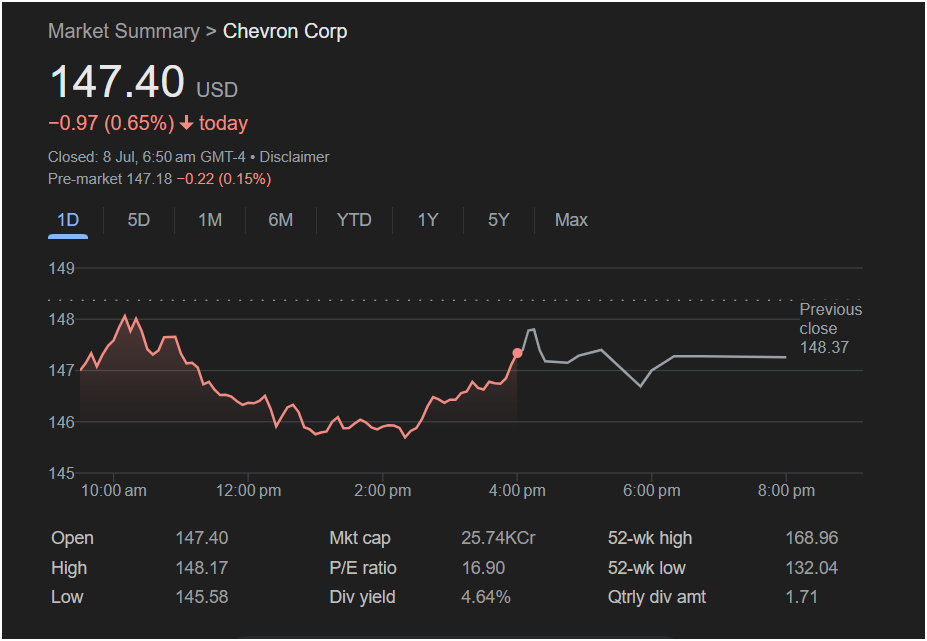Chevron Stock Slides Despite Late-Day Rebound, Highlighting Investor Jitters Over Energy Outlook

SAN RAMON, Calif., July 8 – Shares of integrated energy giant Chevron Corp (NYSE: CVX) finished in the red on Monday after a volatile trading session that saw the stock rebound significantly from its lows but ultimately fail to overcome early selling pressure. The stock closed at
0.97 (0.65%) for the day, reflecting underlying uncertainty in the global energy markets.
The day’s trading was a tale of two halves, painting a vivid picture of the push-and-pull forces currently acting on the energy sector. Chevron gapped down at the open, starting the day at its eventual closing price of $147.40, well below the previous session’s close of $148.37. The stock was immediately hit by a wave of selling, pushing it to its intraday high of
145.58** in the early afternoon.
From that low, however, a significant recovery took hold. Buyers stepped in, driving the stock back up more than $2 in a rally that suggested dip-buyers were attracted to the stock’s valuation and dividend. Yet, this bullish momentum fizzled out as the stock approached its opening levels. Continued weakness was signaled in post-market trading, with the stock ticking down a further 0.15% to $147.18.
A Battleground Stock: Dissecting the Financials
Chevron’s stock is a cornerstone for many value and income-oriented portfolios, and its daily movements are heavily scrutinized. An analysis of its core metrics reveals why Monday’s session was so contested.
-
The Dividend Anchor (4.64% Yield): The most compelling feature for many Chevron investors is its formidable dividend. With a quarterly payout of $1.71 per share, the stock offers a robust dividend yield of 4.64%. This is more than triple the average yield of the S&P 500 and serves as a powerful magnet for income-seeking capital. In a session like Monday’s, this high yield acts as a crucial support mechanism. The strong rebound from the $145.58 low was almost certainly fueled by investors seeing the sell-off as an opportunity to “lock in” this attractive yield at a lower price point.
-
The Value Proposition (P/E Ratio of 16.90): Chevron trades at a Price-to-Earnings ratio of 16.90. This moderate valuation places it squarely in the “value stock” category. Unlike growth stocks with high P/E ratios based on future potential, Chevron’s valuation is closely tied to its current earnings and, by extension, the prevailing price of oil and natural gas. This makes the stock highly cyclical. A P/E of 16.90 suggests that investors are not paying a significant premium for the stock, but it also reflects the market’s awareness that its fortunes are inextricably linked to the volatile commodity markets.
-
Range-Bound Performance (Position in 52-Week Range): The closing price of
132.04 – $168.96). This positioning signifies a stock in consolidation, lacking a clear directional trend. It is neither approaching a breakout to new highs nor breaking down to new lows. Monday’s trading, with its sharp fall and equally sharp recovery, perfectly encapsulates this state of investor indecision.
Macro Forces at Play: The Unseen Drivers
The performance of an energy supermajor like Chevron is rarely about company-specific news; it’s a reflection of the global macroeconomic and geopolitical landscape. The day’s volatility was likely driven by external factors such as:
-
Fluctuations in Crude Oil Prices: The primary driver for Chevron’s stock is the price of Brent and WTI crude. A morning dip in oil prices, perhaps due to concerns about global demand (e.g., weak economic data from a major economy like China) or signs of increasing supply, would directly translate into selling pressure for Chevron. The afternoon rebound in the stock may have coincided with a recovery in the price of oil.
-
Economic Growth Outlook: As a cyclical stock, Chevron is highly sensitive to forecasts for global economic growth. Fears of a slowdown or recession translate into expectations of lower energy demand, which weighs on the entire sector.
-
Geopolitical Stability: Tensions in key oil-producing regions like the Middle East can create supply uncertainty and drive prices higher, benefiting Chevron. Conversely, any signs of easing tensions can have the opposite effect. The day’s swings could reflect shifting news on this front.
Outlook: Navigating the Crosscurrents
For investors, Chevron remains a classic play on the energy cycle, supported by a best-in-class dividend. The path forward will be dictated by the trajectory of commodity prices.
Key technical levels are now clearly established. The day’s low of
148.17 and the previous close of $148.37 represents a significant hurdle that the stock must overcome to regain positive momentum.





